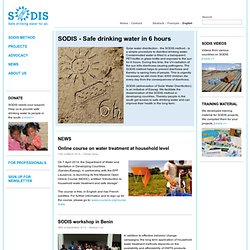

Como Fazer a Fossa de Bananeira – Saracura. Simple tree branch filter makes dirty water drinkable. To turn dirty lakewater into drinkable H2O, peel away the bark from a nearby tree branch and slowly pour water through the wood. According to new research, this neat, low-tech trick ought to trap any bacteria, leaving you with uncontaminated water. Okay, time for a little tree physiology. To get water and minerals up a tree, wood is comprised of xylem, porous tissue arranged in tubes for conducing sap from the roots upwards through a system of vessels and pores. Xylem tissue is found in sapwood, the younger wood that lies in concentric circles between the central heartwood and the bark.
Tiny pores called pit membranes are scattered throughout the walls of the vessels, allowing sap to flow from one vessel to another, feeding various structures along a tree’s length. Turns out, the same tissue that evolved to transport sap up the length of a tree also has exactly the right-sized pores to allow water through while blocking bacteria. How to get fresh water out of thin air. Image Credit: MIT Fog-harvesting system developed by MIT and Chilean researchers could provide potable water for the world’s driest regions.

CAMBRIDGE, Mass. — In some of this planet’s driest regions, where rainfall is rare or even nonexistent, a few specialized plants and insects have devised ingenious strategies to provide themselves with the water necessary for life: They pull it right out of the air, from fog that drifts in from warm oceans nearby. Now researchers at MIT, working in collaboration with colleagues in Chile, are seeking to mimic that trick on a much larger scale, potentially supplying significant quantities of clean, potable water in places where there are few alternatives.
Fog harvesting, as the technique is known, is not a new idea: Systems to make use of this airborne potable water already exist in at least 17 nations. Fog-harvesting systems generally consist of a vertical mesh, sort of like an oversized tennis net. Credits: Global Buckets - Nightly. Welcome to SODIS. Online course on water treatment at household level 10th of March 2014 – Fabian Suter On 7 April 2014, the Department of Water and Sanitation in Developing Countries (Sandec/Eawag), in partnership with the EPF Lausanne, is launching its first Massive Open Online Course (MOOC), entitled “Introduction to household water treatment and safe storage”.

The course is free, in English and has French subtitles. For further information and to sign up for the course, please go to: www.coursera.org/course/hwts. SODIS workshop in Benin 26th of September 2013 – Samuel Luzi In addition to effective behavior change campaigns, the long term application of household water treatment methods depends on the availability and affordability of HWTS products (SODIS bottles, chlorine tablets of solution, filters). Enabling choices 12th of August 2013 – Matthias Saladin A letter about SODIS from Neema Achieng 16th of July 2013 – Fabian Suter. Simple "T" venturi...cheap and effective. Water Central: water cycle, water supply, water conservation,